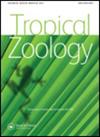弗雷加塔壮丽护卫舰鸟这一全球重要种群面临的潜在威胁
IF 0.4
4区 生物学
Q4 ZOOLOGY
引用次数: 3
摘要
海鸟追踪已被用于确定觅食热点、迁徙路线,并评估种群面临的海上威胁。其中一个威胁是海鸟与渔业之间通过附带副渔获物可能产生的负面互动。2012年,在英属维尔京群岛(BVI)全球重要的繁殖地,60只华丽的护卫舰鸟Fregata华丽被发现被鱼线缠住死亡。为了评估觅食行为和捕鱼活动之间的潜在关系,数据记录器被部署在繁殖大型护卫舰鸟类上,以记录觅食活动。此外,还对当地渔民进行了一项调查,以评估附带副渔获物的规模。我们从GPS和GPS-GSM记录仪记录了28次完整的觅食行程,以及1758个PTT位置。鸟类数量高达3.3–1067 距离它们的繁殖地公里,并进入了10个邻近地区的水域。高比例的渔民(93% = 28)报道称,每年至少捕获一只海鸟,其中最常见的是华丽的护卫舰鸟和棕色的鲣鸟苏拉白鳍豚。据估计,英属维尔京群岛及其邻近岛屿的休闲和手工捕鱼船队中至少有1112艘船只。因此,这种大规模的渔业可能会对该地区的海鸟种群产生潜在的深远影响。本文章由计算机程序翻译,如有差异,请以英文原文为准。
Potential threats facing a globally important population of the magnificent frigatebird Fregata magnificens
Tracking of seabirds has been used to identify foraging hotspots, migratory routes and to assess at-sea threats facing populations. One such threat is the potential negative interaction between seabirds and fisheries through incidental by-catch. In 2012, 60 magnificent frigatebirds Fregata magnificens were found dead, entangled in fishing line, at the globally important breeding site in the British Virgin Islands (BVI). To assess the potential relationship between foraging behaviour and fishing activity, data loggers were deployed on breeding magnificent frigatebirds to record foraging movements. In addition, a survey of local fishers was conducted to assess the scale of incidental by-catch. We recorded 28 complete foraging trips from GPS and GPS-GSM loggers, and 1758 PTT locations. Birds travelled up to 3.3–1067 km from their breeding colony and entered the waters of 10 neighbouring territories. A high percentage of fishers (93% n = 28) reported catching at least one seabird annually, of which the most common were magnificent frigatebirds and brown boobies Sula leucogaster. There are estimated to be at least 1112 vessels in the recreational and artisanal fishing fleets of BVI and its neighbouring islands. Thus, this substantial fishery may have potentially profound effects on seabird populations in the region.
求助全文
通过发布文献求助,成功后即可免费获取论文全文。
去求助
来源期刊

Tropical Zoology
生物-动物学
CiteScore
2.50
自引率
0.00%
发文量
1
审稿时长
>12 weeks
期刊介绍:
Tropical Zoology is an international zoological journal publishing original papers in the field of systematics, biogeography, phylogeny, ecology and conservation of all terrestrial and aquatic animal Phyla from tropical and subtropical areas.
Only papers with new information, high quality and broad interest are considered. Single species description and checklists are not normally accepted. Review papers are welcome. The journal is owned by the Istituto di Ricerca sugli Ecosistemi Terrestri of the Consiglio Nazionale delle Ricerche, Florence, Italy (CNR-IRET) who performs research into the structure and functioning of aquatic and terrestrial ecosystems, focusing in particular on anthropogenic pressure and global change. The knowledge amassed forms the scientific basis for identifying the most appropriate protective and corrective interventions, and provides support for the bodies entrusted with formulating policies for environmental protection and recovery.
 求助内容:
求助内容: 应助结果提醒方式:
应助结果提醒方式:


